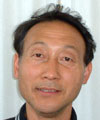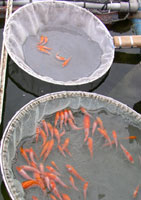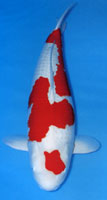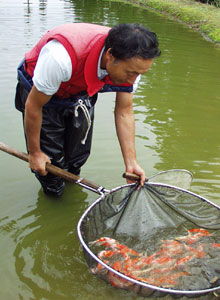
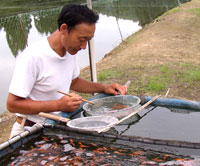 In the early 1970s upon graduating from high school, I went in the Koi business without learning from anybody. My parents were office workers, but since we always had rice fields in the Shiodani district and since I had always watched my relatives and seniors run Koi businesses, I wanted to use the fields for growing Koi, not rice. I was drawn to their dedication for Koi raising, and at the same I became attached to Nishikigoi itself, too. At the time, the winter custom was to work away from home, but I couldn’t do that because my mother was sick. So I spent the winter feeding the Koi in the mountain ponds, and that was probably the reason I became attracted to “the beauty and charm of Nishikigoi” In the early 1970s upon graduating from high school, I went in the Koi business without learning from anybody. My parents were office workers, but since we always had rice fields in the Shiodani district and since I had always watched my relatives and seniors run Koi businesses, I wanted to use the fields for growing Koi, not rice. I was drawn to their dedication for Koi raising, and at the same I became attached to Nishikigoi itself, too. At the time, the winter custom was to work away from home, but I couldn’t do that because my mother was sick. So I spent the winter feeding the Koi in the mountain ponds, and that was probably the reason I became attracted to “the beauty and charm of Nishikigoi”
Since then, I set a goal on becoming champion at national Koi shows. It took me 10 years to raise “Scarlet Queen”, Grand Champion of The 30th All Japan Nishikigoi Show held by Zen Nippon Airinkai. The Kohaku of the Shiodani district was known to have nice patterns but not to grow very big, so I focused on making them big. I made efforts by visiting Dainichi Koi Farm to acquire breeding methods and by asking Koi lovers in order to have prize-winning Koi as my oyagoi. I was very happy when all of my efforts culminated in winning the Grand Champion. The attraction of Scarlet Queen is the outstanding quality of the shiroji and beni and the “Pink beni.” This type of beni was known not to grow because of its hard ground, but it did. I believe that Nishikigoi change daily because they are living creatures. There is no correct Nishikigoi because they change at a bewildering pace depending on present trends and technological progresses. That is why breeders are required to have strong beliefs in “producing their ideal Nishikigoi.” I received a major blow by the 2004 Niigata Earthquake. I lost many female oyagoi that I had bred up to then, but I haven’t forgotten my belief in “producing a Koi that would be loved by everybody,” and at the present, I am committed to producing the “New Kansuke Kohaku.”
I would like for worldwide Koi lovers to raise Koi that live long, not only one that has a good appearance. Even if a Koi does not look so nice at the tosai stage, it will become fine if it is of good quality. The fukurin which I recommend is something you can’t see when the Koi is young, so I hope you have the chance to see and feel it by raising a large sized Koi. But it’s not always the case that the breeders’ opinions are correct in raising Koi, so it would be nice to learn more about Nishikigoi together with many Koi lovers. |
|
||||||||||||||||||||||||||||||||||||||||||||
| (Interviewed on March 15, 2006) | |||||||||||||||||||||||||||||||||||||||||||||
|
*Fukurin (who' coo reen ) Scale Wrap. It is the cuticle of the skin which appears as a line drawn in a ring around a scale. This name was taken from the term Fuku (meaning to "cover" or "wrap") and Rin (meaning "scale"). Fukurin is most noticeable in Hikarimono, and was originally thought to occur only in metallic varieties because it was harder to see in other varieties. Fukurin is now also seen in large sized Kohaku and Taisho Sanshoku (Sanke). |
|||||||||||||||||||||||||||||||||||||||||||||

